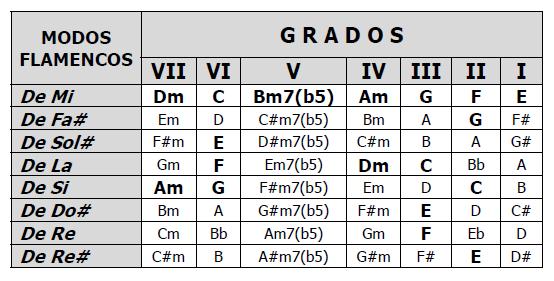|
mezzo -> RE: the fifth degree in flamenco modes (Nov. 17 2011 8:14:29)
|
Thanks for that chords Ricardo.
Tomrocker you're welcome.
This info was already present on the foro, if you made search, you could find topics and posts explaining the various modes.
Nice thing is that table gives a good overview. But it's just super basic. It tells you the chord family but not precise if it's F7 or C9...
The D natural mode is also considered phrygian?
Coz what i notice is there are 7 degrees and 7 modes (8 with the D natural).
As for the scale pattern (for the picado) there are also 7 differents.
Regarding minor and major key for the cante, it would be nice if you or someone else could precise, following the same structure as the pic above, the chord/degree?
- - - - - - - - - - - - - -
Edit: I'd just to clarify something maybe unclear
quote:
mezzo:
So when resolving, we substitute the m7b5 chord.
And when we begin a progression, we avoid it. Using the A7 (passing chord) to land on Dm (according to the letra). (?)
What i meant was if the 1st degree is the resolution chord, the final chord of a progression.
What about the beginning of a progression?
In a solea de alcala (E) or a tientos (A) some of the letra begin with the E7 to Am or A7 to Dm.
So as I understand the trick, these E7 and A7 are not from the 1st degree, but they're the passing chord from V to IV. right?
The confuzion come from that these passing chords are from the same family as the 1st degree.
So as you said vm7b5 : "It is a weak chord to begin with because it does not contain a perfect 5th."
While starting a progression, guitaristas prefer to play the passing chords instead of the Vth? Or these chords are from the 1st degree?
quote:
a big fight with dr Whitehead and Mcguire ...
I remember that. Weird to fight like this just for a chord.
Btw my intention is not polemical, I'd just to understand what's going on with this Vth.
|
|
|
|

